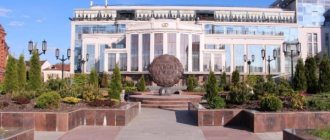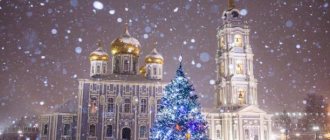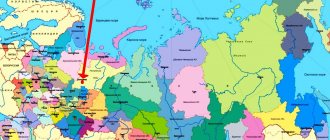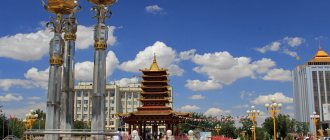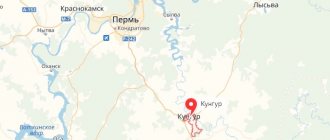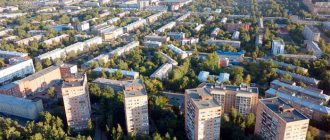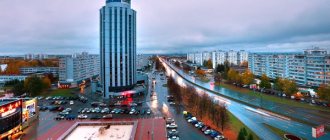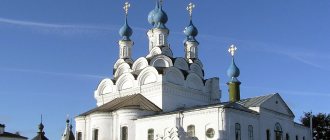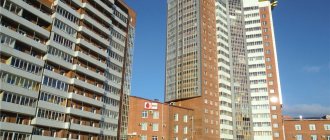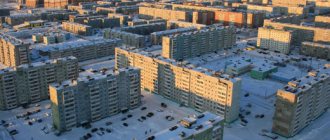Monument to dumplings
Who would have thought that there was such a miracle in the world. The dumplings monument really exists in Izhevsk. It was opened not so long ago - in October 2004. It is located near the Pozim cafe, which is located on the street. Kraeva. It consists of a huge fork on which a dumpling is placed. Its blunt end is stuck into the base of the monument. The dimensions of the original and unusual monument: one meter in diameter, height – exactly three meters.
The very story of how the dumpling monument in Izhevsk came into being is interesting. In general, the name of this meat dish comes from the Udmurt word “pelnyan”, which means “bread ear”, but in the Russian version it has changed slightly. The authors of the project were the Archeopteryx group. In their opinion, this place will not only attract tourists, but also attract newlyweds. Dumplings are a must-have dish for every wedding celebration in Udmurtia.
What to see depending on the time of year
Izhevsk has a temperate continental climate - warm but short summers and cold but long winters. The warmest month is July, so tourists prefer to come here in the summer. Seasonal attractions include annual cultural festivals. The “Red Festival” is popular.
"Red Festival"
The Red Festival is a traditional annual celebration that first took place in 2004. This festival is closely associated with the color red and is held over 6 days. As part of the event, concerts and competitions are held (“Red-haired pet”, “The red-haired person”, “Red-haired toy”, etc.). During the festival, charity events, a bicycle parade and city celebrations are also held. City parks are used for the festival.
The purpose of the festival is to popularize the ethnic group and patriotic education of youth. The fact is that the Udmurts are considered the reddest people of Russia and the world. On a broader level, only the Irish can compare with the Udmurts.
Video: “Red Festival” in Izhevsk
Monument to the crocodile
Another masterpiece is no less interesting. This is a monument to a crocodile in Izhevsk. It was installed recently - in 2005, and is located at the intersection of Kommunarov and Sovetskaya streets. It was invented by student Asen Safiullin, who studied at the Institute of Arts. The organizers of the project were the city administration, Elektromash and Gallery.
A city competition was announced for the best model of the future monument. At the same time, the following requirements were put forward: humor and irony. The monument to the crocodile in Izhevsk had to have a connection with both the present and the past of the city. Over 20 sculptors tried their hand at this original competition. And Asen won. The sculpture was created by the hands of Pavel Medvedev.
The monument was smelted from cast iron at the factory. Many changes were made to the original layout. As a result, the crocodile is sitting on a bench, wearing a top hat on his head and a bow tie around his neck. The monument has become a symbol of independence and freedom.
Temple of the Iveron Icon of the Mother of God
The shrine is located on the outskirts, but this is not at all an obstacle for those who want to get here. The building is very picturesque, mostly framed in blue and beige tones. The temple vaguely resembles St. Michael's Cathedral. However, this building has an impressive difference: it was built of white brick (and not red, like the restored cathedral), and, moreover, it was decorated with natural stone.
Gunsmiths, captured for centuries
There are more understandable and classic monuments in the city. The Izhevsk plant, created by decree of Alexander I, still produces weapons. And the monument to gunsmiths in Izhevsk is a tribute to the people who, over the years, glorified the enterprise throughout the country. Their work for the benefit of Russia will never be forgotten by their descendants. It was at this plant that Kalashnikov assault rifles, Bisons, the modern Abakan and many other types of weapons were produced.
For the monument, images were taken from old photographs. It represents common people and is a symbol of gunsmiths. It was opened in 2007. It is located right in front of the factory museum. The monument is made in the form of two figures dressed in caftans and top hats. It reaches a height of 2.7 meters, and if measured together with the pedestal, then 4 m. This sculpture weighs about four tons. The names of famous factory craftsmen are immortalized on it.
Kalashnikov Museum
Gun lovers should definitely check this place out. The Kalashnikov complex has been operating since 2004. It was from that time that many tourists began to come to the city to look at the huge number of small arms. This museum has one significant difference from other similar institutions - there is a shooting range. That is, guests can not only get acquainted with the exhibits, but also shoot.
The original monument to Zvezdochka
Izhevsk is also known for its monuments created in honor of animals. The monument to Zvezdochka was opened in the city in 2006. The author of the project was the famous sculptor of Izhevsk - Pavel Medvedev. As many remember, there were dogs on board one of the first Soviet spacecraft. One of them was Zvezdochka. Our heroine went into space in 1961. On the same day, the ship returned, landing in the Udmurtia region. Pilot Lev Okkelman found him and brought the dog to the airport. She lived there until she was taken to the capital.
This dog became the last flight tester. After her, the first man was sent into space. The monument looks as if a mongrel is peeking out of a ship's hatch. A lot of information is written on the surface of the monument, which is accessible not only to the sighted, but also to the blind. Some inscriptions are engraved in a special font for the blind.
The idea belonged to Sergei Pakhomov. Together with schoolchildren, they sculpted a ship and a dog out of snow. After this, the children wanted to erect a real monument to the astronaut. The sculptor was inspired by this idea. And soon the monument was ready.
How long does it take to look around the city?
One day is enough for a quick tour of the main attractions of Izhevsk. But a deep, informative and detailed excursion can take up to 3 days. The Kalashnikov Museum alone requires 3-4 hours (provided you are interested in history). A walk along the embankment of the Izhevsk Reservoir also takes several hours. If you decide to explore all the beautiful places in the city, you need to take care of accommodation for the night. It is better to book a hotel room in advance. Here are a few establishments on whose website you can book the room you need:
- three-star hotel "Amaks Central";
- four-star hotel Park Inn by Radisson Izhevsk;
- Hotel "Deryabin" (3 stars);
- Hotel "Nomer-Ok";
- hostel "Dacha".
What else to see
If you have time left, visit another place - the Bird Theater.
Theater-studio "Bird"
"Bird" is an amateur theater group. The history of the troupe began with a small theater club in one of the Izhevsk schools. Anyone, even a completely inexperienced actor, can become an actor in this theater. The group's repertoire includes many performances and show programs. The theater does not have a regular operating schedule, but performances are held regularly, so tourists can visit the small “Birds” stage, located in the Saturn club building.
Information for tourists:
- address: 40 Let Pobedy Street, 110 (Saturn Club);
- You can get to the theater by buses No. 40, 27, 28 and 32 (stop “Your Home”);
- official website: https://theater-bird.ru;
- the theater is open on performance days;
- Ticket price depends on the performance.
The most popular production of “Birds” is the play “Censor”, which is popular with local residents
Famous monuments of Izhevsk
Among them, one bust standing on a pedestal is popular. This is a monument to Deryabin in Izhevsk. This man lived in pre-revolutionary times. He has a ribbon over his shoulder, and the Order of Anna hangs on his chest. Deryabin was one of the builders of the arms factory, and it was his work that allowed the city to become famous throughout the world.
This man left a big mark on the history of Russian industry and technology. He was born into the family of a priest and spent his childhood among mining prospectors. They excited his imagination with stories of countless treasures. Being impressed by them, Deryabin went to St. Petersburg to study at the mining school.
Over time, he visited many mines and factories in Germany, England and France. Traveling not only significantly expanded his horizons, but also contributed to the acquisition of invaluable knowledge and experience. This is what helped Deryabin’s promotion in his homeland. When it was decided to build a weapons factory, it was his project that was preferred.
St. Michael's pillar
Some monuments in Izhevsk are also dedicated to the dynasty that ruled Russia. For example, the sculpture, which was erected in honor of Grand Duke Mikhail Romanov, is the only monument in his honor in the entire country. The prince headed the Artillery Department. He was the highest commander of the Izhevsk arms factory. Not all monuments in the city of Izhevsk have retained their original appearance, and so it happened with this one. The sculpture - for obvious reasons - was demolished under Soviet rule, and it was restored only in 2007. The Mikhailovsky Pillar is located on the territory of the Izhmash Palace of Culture.
Main building of the arms factory
The main complex of factory buildings is one of the main symbols of the city, reminiscent in its appearance of the St. Petersburg Admiralty. Construction of the front building of the main building took place in the first half of the 19th century and was completed in 1844. Its central portal is decorated with semi-columns. An elegant tower topped with a column rises above the 2-tier attic. In tsarist times, it housed a bronze sculptural composition: a double-headed eagle raising its wings above captured cannons and banners. Since 1838, chimes have been placed on the pediment of the building, and in the lower tier of the tower there are ten chiming bells. In a fit of revolutionary enthusiasm in the first years of Soviet power, a bronze composition with a double-headed eagle was thrown into a pond, where it was lost.
Ironic sculpture
Monuments of the city of Izhevsk are also presented in several humorous copies. One of them is a sculpture of an ordinary goat. Its grand opening took place in 2006. They erected a monument in the Birch Grove, a well-known city park. The authors are Dmitry Postnikov and Alexander Suvorov.
This sculpture did not appear by chance, but as the personification of Izhevsk’s past. More than a century ago, the park where the monument was erected was a natural area where workers constantly came to rest after hard factory shifts. But urban construction did not stand still and was constantly expanding. As a result, private houses began to appear nearby, and residents grazed goats in the park. Animals ran around and were in full view of everyone. This place was even nicknamed “Goat Park”.
Architect Dudin Embankment
There is a place in Izhevsk that is impossible to pass by without noticing the view of the embankment. It is named after the first architect of this city. Locals love to spend their free time here. People come here to rest their souls. It’s not difficult when you watch how the serene waves of Izhevsky Pond touch the edge of the embankment. And in the distance there are cityscapes.
Lenin
Monuments of Izhevsk include a monument to the great leader of the proletariat. It was originally a small bronze bust on a simple marble-painted wooden pedestal. It was built in 1926, after the death of the great leader. He was on the stairs that went down from Sovetskaya Street towards the dam.
It was supposed to lift the spirits of the workers who passed by it every day. But the wooden pedestal quickly deteriorated. As a result, a new monument appeared, only now in the form of a bronze statue. It was solemnly opened again on the day of the annexation of Udmurtia to Russia.
Other monuments
Several other works of art are also presented to tourists and guests of the city. For example, the Monument to Friendship of Peoples, which was opened in 1972. It was created in honor of the 4th anniversary, after Udmurtia joined Russia. Its height is 46 meters (about the size of a 16-story building). People often called it “Kulakova skis.” And this second name stuck to it after the Izhevsk skier was able to win three gold medals in Sapporo. There is an interesting legend: if you stand facing the monument and then ask yourself a question three times, the monument will definitely give the correct answer.
There is also a monument to Los in Izhevsk. And a number of sculptures that were installed after the Chernobyl accident. “Bird with Broken Wings” is also interesting, which was created as a memory of the victims of local conflicts. There is a cast statue of a steel worker right next to the plant. And the Wolf resides forever in the city zoo. If you visit the northern cemetery, you can see the WWII memorial there. And, of course, there is a monument to Pushkin in Izhevsk; a sculpture of the poet can be found in almost any city. It’s just done differently everywhere. And next to one of the city’s hairdressers there is an original monument “Scissors with a comb”.
Izhevsk is an interesting city with a rich history. Of course, every tourist should visit it. There is a lot to see here: historical and modern sculptures, architectural monuments, picturesque parks and squares. Guests of the city will leave here with beautiful and original photographs for their photo album.
1. Monument “Friendship of Peoples”
Opened in 1972, the Friendship of Peoples monument symbolizes the 400th anniversary of Udmurtia’s voluntary entry into the Russian state. The second name “Forever with Russia” was given to it by the authors: sculptor Alexander Burganov and architect Roman Topuridze. The monument consists of two parallel 48-meter stainless steel steles, personifying two peoples.
The common people call the monument “Kulakova’s Skis” because of the similarity of shapes and in honor of the famous skier Galina Alekseevna Kulakova. This famous resident of Izhevsk, shortly before the opening of the monument, won 3 Olympic gold medals in cross-country skiing at the XI Winter Olympic Games in the Japanese city of Sapporo.
There is an interesting sign according to which you can get an answer to each question if you ask it three times, standing facing the monument.
2. St. Michael's Column
Initially, the monument was erected in 1852 by decree of Emperor Nicholas I in honor of Grand Duke Mikhail Pavlovich. The total height of the cast iron column, the top of which was decorated with a bronze angel holding a cross, was 28.3 meters. The mention of the monument in the past tense is due to the fact that after the Great October Revolution in 1918, the column was destroyed.
After 89 years, the monument was restored, but the restorers were unable to reproduce the recognizable features of the original. The height of the new column is 19 meters, the shape has changed to a cone, and the sculpture of an angel, made by Pavel Medvedev, has little in common with the previous figure. Despite this, the column is considered an iconic place in Izhevsk, referencing the rich historical traditions of the city.
3. Monument to A.F. Deryabin
The monument is dedicated to the founder of the Izhevsk Arms Plant, an outstanding public figure, one of the largest mining engineers - Andrei Fedorovich Deryabin. A bust in the uniform of Alexander's times, decorated with the Order of Anna and a ribbon over the shoulder, was installed in 1907 to commemorate the centenary of the Arms Factory. The sculptor Ivan Nikonorovich Sitnikov achieved an amazing resemblance, despite the fact that the source of the image of Deryabin for the author was only an ancient engraving.
Located on the picturesque embankment, the bust is deservedly considered one of the most popular monuments among the local population and guests of the city.
4. Monument to Izhevsk gunsmiths
It is symbolic that the only monument to gunsmiths in the world is located in Izhevsk, the arms capital of Russia. The prototype of the exhibition for the sculptor Pavel Medvedev and the architect Irina Khodyreva were old photographs of the craftsmen of the Izhevsk plant. The monument was inaugurated in 2007, in honor of the 200th anniversary of the Izhevsk Arms Factory and the 60th anniversary of the invention of the Kalashnikov assault rifle.
The monument is a bronze image of two masters on a granite pedestal, and the total weight is about 4 tons. At the foot of the monument there are slabs with the names of outstanding personalities who made an important contribution to the arms business of Izhevsk.
5. Monument to the Eternal Student
The official name of the monument located in the center of the campus is “Glory to Science.” At the same time, for more than half a century, the monument depicting a young man holding an atom on his hand has been called by another symbolic name - “Monument to the Eternal Student.”
The prototype of the monument was two students of Izhevsk State Technical University. The famous sculptor Boris Volkov reflected in his work the athletic physique of the chairman of the student trade union committee A. Gubin, and the face of the monument was V. Kosenko, a member of the institute committee of the Komsomol.
There are many unique traditions associated with the monument. Local students more than once dressed their “eternal” brother in different costumes, put bottles in his hand, and also made symbolic bonfires from notebooks under his feet. In addition to a fair amount of student pranks, the "Eternal Student" was the starting point for many sports runs and official events at the city and state levels.
6. Sculpture “Izhik”
- This is a one and a half meter sculpture of a boy dressed in a traditional caftan of a master gunsmith of tsarist times. The whole of Izhevsk took part in the creation of the future symbol of the city. The movement of children of the Oktyabrsky district came up with the idea; the material for the sculpture was old keys and metal from utility services collected by residents, and the monument was cast by workers of the steel foundry shop of the Izhstal plant.
The symbol of the city is located on the Central Square of the city, a short walk from the Park Inn by Radisson Izhevsk hotel.
The resulting monument was so loved by the townspeople that the management of the Izhstal plant decided to install a smaller copy of it on its territory - so to speak, Izhik’s younger brother.
7. Monument to the crocodile
Since 2005, a two-meter crocodile in a tailcoat, top hat and bow tie has been located on a cast-iron bench in the park. The monument, created according to the model of Asen Safullin by sculptor Pavel Medvedev, was presented to the city during the “Cultural Capital of the Volga Region” event.
Most of us have a positive image of the crocodile as a kind, friendly and harmless representative of the animal world thanks to the magnificent character “Crocodile Gena” from the book by Eduard Uspensky.
However, despite the obvious similarity with the cartoon image, the local population sees in the monument an important symbolic meaning for Izhevsk. According to one version, the name of the river Izh, in Old Murtsk Ochsh, is associated with the name of an ancient mythical lizard. According to another version, in pre-revolutionary times, gunsmiths received branded government clothing - green caftans, the wearers of which quickly became known as “crocodiles.”
8. Monument to dumplings
One of the most controversial monuments in Izhevsk opened in 2004. A vertical three-meter fork piercing a huge dumpling was presented to local residents as a result of the Contemporary Urban Sculpture festival.
The author of the monument, Alexey Shklyaev, wanted to pay tribute to ancient traditions with his work and, once again, to indicate the geographical point of origin of this product. According to etymological dictionaries, “dumpling” comes from the Finno-Ugric “pelnyan” - bread ear.
Local residents were divided in their opinions as to whether such an unusual monument could be considered a work of art, but they agreed on one thing - it definitely whets the appetite.
9. Monument to the goat
More than a hundred years ago, the Berezovaya Roshcha park, also called the Goat Park, was a resting place for workers of the Izhevsk plant. Over time, the nearby area was built up with private houses, the owners of which grazed their goats in the park.
Sculptors Alexander Suvorov and Dmitry Postnikov created the monument on their own, and the material for the original sculpture was city scrap metal. The authors expected quite a skeptical attitude towards their work, but they soon noticed that a ribbon was tied around the neck of the monument. The sculptors’ joy knew no bounds, because this is exactly what loving owners did with their pets, which means that the residents of the city liked the sculpture.
10. Monument to the dog-astronaut Zvezdochka
In 2006, another one was added to the monuments of Izhevsk - a monument to the cosmonaut dog Zvezdochka, not as famous as her brothers Belka and Strelka, but who played a very important role in the history of space exploration. It was Zvezdochka who became the last representative of her species, after whose successful landing it was decided to launch the first man into space. The satellite ship returned to earth on March 25, 1961, and already on April 12 of the same year, Yuri Gagarin went into orbit.
The monument to the Star, designed by Izhevsk journalist Sergei Pakhomov, was made in cast iron by sculptor Pavel Medvedev.
Source: https://blog.radisson.ru/

